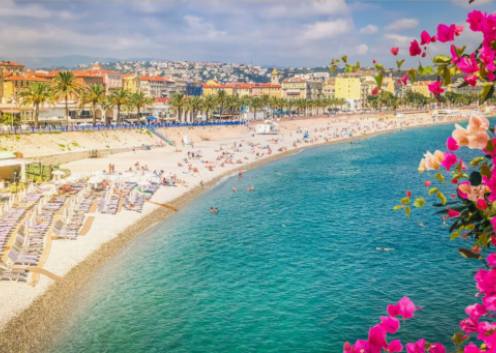Enter the enchanting world of Marc Chagall, a master of color and symbolism in the art world. The Marc Chagall National Museum offers a rare glimpse into the artist's unique universe, showcasing his iconic masterpieces and exploring the deep meanings behind his work. Dive into the magical realm of Chagall's artistry and discover the profound influence he has had on modern art movements. Join us behind the scenes as we uncover the meticulous curation process that brings Chagall's vision to life in this extraordinary exhibition.

Exploring Chagall's Masterpieces at the National Museum
Nestled in the beautiful city of Nice, France, the Marc Chagall National Museum offers visitors a unique opportunity to explore the masterpieces created by the renowned artist himself. The museum houses an extensive collection of Chagall's works, providing an intimate look into the artist's creative genius and unique vision. As visitors wander through the museum's galleries, they are captivated by Chagall's vibrant colors, dreamlike imagery, and poignant storytelling, all of which come together to create an immersive and unforgettable experience. From his iconic paintings depicting scenes from the Bible and Russian folklore to his enchanting stained glass windows and tapestries, Chagall's artwork continues to enchant and inspire art lovers from all around the world. Exploring Chagall's masterpieces at the National Museum is a journey into the heart and soul of one of the greatest artists of the 20th century.
Symbolism and Meaning in Chagall's Art
Marc Chagall, one of the most renowned artists of the 20th century, is known for his unique style that blends elements of Cubism, Symbolism, and Fauvism. His art is characterized by vibrant colors, dreamlike imagery, and a sense of magical realism. Throughout his career, Chagall explored themes of love, faith, and folklore, creating works that are deeply symbolic and rich in meaning.
One of the recurring symbols in Chagall's art is the image of the flying lovers. These ethereal figures, often depicted floating in the air or soaring above the rooftops, represent the artist's belief in the power of love to transcend boundaries and limitations. The lovers also symbolize Chagall's own personal experiences of love and longing, as he often incorporated images of his beloved wife Bella into his paintings.
Another prominent symbol in Chagall's art is the image of the rooster. In many of his works, the rooster is depicted as a symbol of fertility, rebirth, and resurrection. Chagall often used this symbol to evoke themes of renewal and transformation, as well as to explore the cyclical nature of life and death.
Chagall's use of religious imagery is also central to his art, as he drew upon his Jewish heritage and beliefs to create works that are steeped in spirituality and mysticism. His paintings often feature scenes from the Bible, such as the story of Jacob's ladder or the binding of Isaac, which Chagall imbued with his own unique interpretation and symbolism.
Overall, the symbolism in Chagall's art serves to communicate deeper layers of meaning and emotion, inviting viewers to contemplate the universal themes of love, faith, and humanity that resonate throughout his work. Through his use of symbols and imagery, Chagall invites us to explore the mysteries of the human experience and to reflect on the eternal questions of existence and spirituality.
Chagall's Influence on Modern Art Movements
Marc Chagall's influence on modern art movements is undeniable. His unique style and innovative use of color and symbolism have had a lasting impact on the art world. Chagall's work has inspired and influenced a generation of artists, both during his lifetime and long after his passing. His whimsical and dreamlike paintings continue to captivate audiences and artists alike, serving as a source of creative inspiration and a standard of artistic excellence. Chagall's contributions to modern art movements such as Surrealism, Cubism, and Expressionism have solidified his place as one of the most important and influential artists of the 20th century.
Behind the Scenes: Curating the Chagall Exhibition
It involves a deep understanding of the artist's life and work, as well as a keen eye for showcasing the pieces in a way that does justice to their beauty and significance.
The first step in curating a Chagall exhibition is to carefully select the pieces that will be showcased. This involves consulting with art historians, experts, and collectors to identify key works that represent different aspects of Chagall's style and themes. The goal is to create a comprehensive representation of the artist's oeuvre that will give visitors a complete picture of his artistic genius.
Once the pieces have been selected, the curator must consider how to arrange them in the exhibition space. This involves creating a narrative flow that guides visitors through Chagall's life and art, highlighting the evolution of his style and the recurring motifs in his work. The curator must also pay attention to the visual and spatial aspects of the exhibition, ensuring that each piece is displayed in a way that maximizes its impact and allows visitors to appreciate its beauty.
Another crucial aspect of curating a Chagall exhibition is providing context for the artworks. This may involve including informational panels that explain the symbolism and meaning behind Chagall's motifs, as well as his influence on other artists and art movements. Curators may also collaborate with scholars to produce a catalog or guidebook that offers visitors a deeper understanding of Chagall's work and its place in the art world.
Overall, curating a Chagall exhibition is a labor of love that requires a deep appreciation for the artist's work and a dedication to sharing it with the public. By carefully selecting, arranging, and contextualizing Chagall's masterpieces, curators can create a truly immersive and enlightening experience for visitors, allowing them to step inside the artist's universe and see the world through his eyes.
